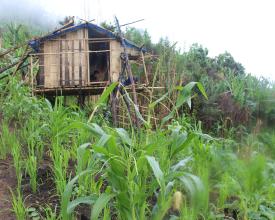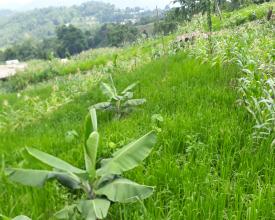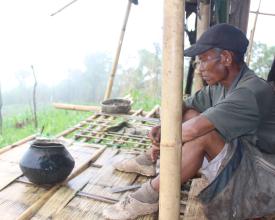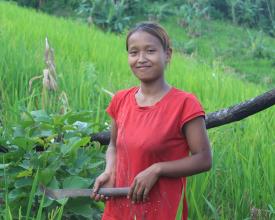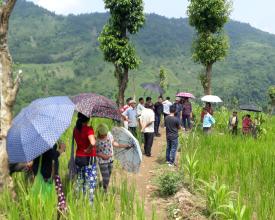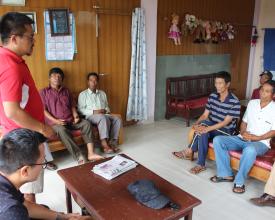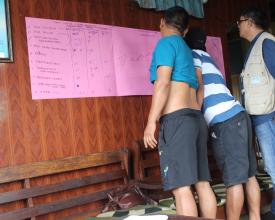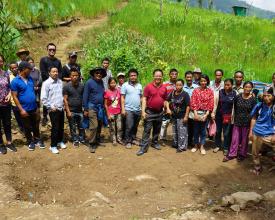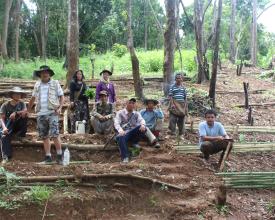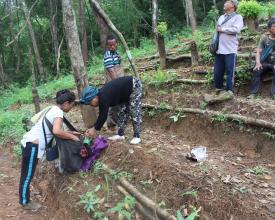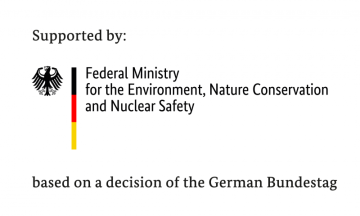Sensibilisation et développement des compétences des utilisateurs des terres sur les mesures d'intensification et d'optimisation du Jhum à Mizoram, en Inde

Le jhum est une pratique agricole que l'on trouve principalement dans le nord-est de l'Inde et qui constitue un mode de vie profondément ancré dans la tradition et la culture des communautés locales de la région.Cependant, dans un passé récent, en raison de changements dans les conditions socio-économiques et les modes d'utilisation des terres, des problèmes tels que la réduction des cycles de jhum, la réduction de la période de jachère, la perte de fertilité du sol et les faibles rendements des cultures ont commencé à apparaître dans les champs de jhum du Mizoram, menaçant ainsi la dégénérescence des riches ressources naturelles de l'État et le bien-être de la communauté qui en dépend directement.
Le projet IKI-Biodiv a contribué à la sensibilisation et au renforcement des capacités des utilisateurs des terres sur les mesures d'optimisation et d'intensification du jhum, ce qui contribuera à promouvoir la biodiversité et les services écosystémiques tout en assurant la sécurité alimentaire et des moyens de subsistance des agriculteurs.
Contexte
Défis à relever
- Lejhumming ou l'agroforesterie en rotation est la principale pratique d'utilisation des terres et la principale source de sécurité alimentaire et de moyens de subsistance pour les communautés rurales du Mizoram depuis des siècles. Cette pratique est bien adaptée à cette région qui crée des paysages culturels et s'est avérée préserver la biodiversité et la forêt à long terme.
- Ces dernières années, le jhum a été mis à mal par les changements d'utilisation des terres, le raccourcissement du cycle du jhum, la réduction de la période de jachère, la perte de fertilité du sol et la diminution du rendement des cultures.
- Il est donc urgent d'aligner les différents services écosystémiques sur la transformation socio-économique rapide qui a lieu au Mizoram. C'est pourquoi on a entrepris de populariser la pratique de l'optimisation et de l'intensification du jhum en introduisant des mesures pour augmenter la période de culture, c'est-à-dire la gestion de la jachère pour restaurer la fertilité du sol, recharger l'humidité du sol et les eaux souterraines, créer des forêts secondaires et d'autres revenus subsidiaires ainsi que renforcer les activités microbiennes et maintenir les écosystèmes.
Emplacement
Traiter
Résumé du processus
- Le premier bloc de construction a permis de combler le manque de connaissances des communautés locales et des utilisateurs des terres en les sensibilisant à l'importance de la conservation de la biodiversité et à ses liens avec leurs moyens de subsistance et leur sécurité alimentaire.
- Le deuxième bloc de construction leur a permis de réaliser que les mesures d'optimisation du jhum ne sont qu'une sorte d'improvisation de la méthode qu'ils pratiquaient déjà et, en les observant pratiquées par leurs homologues du Nagaland, les a aidés à
- d'améliorer leurs connaissances
- à gagner en confiance
- et à les mettre en pratique dans leur village. - Après le renforcement de leurs capacités, le troisième bloc de construction peut répondre efficacement au défi, car la communauté locale dépend de la forêt et de ses ressources pour sa subsistance et la nécessité de la conserver en adoptant diverses pratiques innovantes de bon jhuming.
- Enfin, la solution permettra de convaincre le gouvernement d'intégrer les mesures d'optimisation du jhum dans sa politique.
Blocs de construction
Sensibilisation par le biais de formations et d'ateliers
Afin de sensibiliser aux mesures d'optimisation du jhum déjà pratiquées par les agriculteurs du Nagaland, un atelier de deux jours a été organisé dans le village du projet pour les chefs de communauté, les agriculteurs et les fonctionnaires de terrain du département des forêts. Bien que le jhum soit pratiqué depuis des générations par les villageois, ils ne connaissaient pas les mesures d'intensification et d'optimisation du jhum. Les avantages de ces mesures en termes d'augmentation des revenus agricoles et d'amélioration de la biodiversité et des services écosystémiques ont été expliqués par le biais d'un processus participatif et d'une présentation PowerPoint. L'implication des chefs et des anciens de la communauté, ainsi que des femmes et des jeunes leaders dans le programme de formation a été un avantage supplémentaire, car elle a permis de mettre en évidence l'urgence du programme et de sa mise en œuvre.
Facteurs favorables
- L'orientation des mesures d'optimisation du jhum vers l'agence nodale de l'État, c'est-à-dire le conseil de la biodiversité de l'État et les membres du conseil de village, a été essentielle pour gagner la confiance des parties prenantes.
- La prise de conscience par les agriculteurs et les parties prenantes de l'urgence des problèmes rencontrés et la volonté de participer activement, d'acquérir des connaissances et de les mettre en œuvre dans leur propre jhum.
- La sélection du bénéficiaire qui possède une parcelle dans le champ de jhum actuel a été un avantage supplémentaire.
Leçon apprise
- L'encouragement de tout programme dans le village sous la forme d'apports ou de visites d'exposition pourrait susciter l'intérêt de la communauté pour une participation active.
- La planification participative du programme dans le village avec les participants a suscité plus d'intérêt et de discussions.
Améliorer les connaissances grâce à une visite d'exposition
Une visite d'exposition d'une semaine au Nagaland, du 15 au 20 juillet 2019, a été organisée pour les agriculteurs et les dirigeants communautaires du village. Au cours de la visite d'exposition, ils ont été emmenés dans les champs de jhum et les mesures d'optimisation du jhum adoptées par les agriculteurs Naga ont été montrées. Des interactions entre agriculteurs ont également été organisées, ce qui a permis aux agriculteurs de clarifier leurs doutes. Ils ont également été emmenés à la station de recherche agricole de l'État (SARS) où des recherches sur les mesures d'optimisation du jhum sont menées et l'interaction avec les scientifiques leur a permis d'acquérir de nouvelles connaissances.
La visite d'exposition au Nagaland a eu un impact sur la compréhension de la méthodologie et des avantages d'une pratique améliorée dans leur jhum.
Facteurs favorables
- Le Nagaland a adopté des mesures d'optimisation du jhum qui ont permis d'obtenir d'excellents résultats en termes d'augmentation de l'intensité des cultures dans les champs de jhum.
- Un itinéraire de visite bien planifié a été préparé et la logistique du voyage a été organisée bien à l'avance et la période de la visite a coïncidé avec la saison active du jhum.
- L'autorité gouvernementale du Nagaland a été contactée avant le voyage pour expliquer l'objectif et les détails de la visite.
- La sélection des agriculteurs à visiter a été faite en gardant à l'esprit l'implication des chefs de communauté, des femmes et des jeunes.
Leçon apprise
Cette visite a suscité l'enthousiasme des agriculteurs et a renforcé leur confiance. Le moment de la visite était parfait car toutes les opérations d'optimisation du jhum ont pu être observées sur le terrain. Cette visite a été l'occasion d'échanger du matériel génétique entre les agriculteurs et a permis d'améliorer la conservation de la biodiversité.
L'enseignement le plus important est que la visite d'exposition, en plus d'accroître les connaissances, permet de renforcer la confiance et les liens entre les tribus montagnardes qui pratiquent une utilisation des terres et des modèles de culture similaires dans la région.
Mesures de démonstration pour l'optimisation de Jhum
La démonstration des mesures d'optimisation du jhum dans les champs des agriculteurs sur une base pilote impliquant la communauté montrerait des résultats qui convaincraient les agriculteurs que de petites modifications du système actuel de gestion du jhum feraient une différence en termes de conservation du sol, d'augmentation du niveau de fertilité et d'amélioration de l'humidité du sol tout en augmentant le rendement des cultures et en améliorant les services de l'éco-système.
Facteurs favorables
L'instauration de la confiance entre les utilisateurs des terres et la communauté, ainsi que les enseignements tirés de la visite au Nagaland, ont constitué un avantage supplémentaire, car ils ont pu constater par eux-mêmes la différence que représente la pratique du jhum amélioré.
Les communautés pratiquaient déjà le système agricole du jhum et l'adoption de quelques modifications dans la gestion n'a pas été un problème pour elles.
Leçon apprise
Des interactions régulières et des discussions ciblées avec la communauté et les utilisateurs des terres sont un élément clé de tout programme communautaire. Il est important d'établir une relation de confiance avec le conseil du village et les dirigeants de la communauté, étant donné que les terres et les forêts sont régies par eux et que leurs décisions sont importantes pour le bon déroulement des activités dans le village.
Le moment de la mise en œuvre de ce bloc de construction est très important car il devrait commencer dès la sélection de la parcelle de jhum. Dans ce cas, il y avait déjà des cultures dans le champ de jhum et elles ne pouvaient pas être perturbées. Par conséquent, pour la démonstration, une parcelle de 100 mètres carrés a été sélectionnée à proximité du champ de jhum où les mesures ont été prises.
Ressources
Impacts
- La sensibilisation à la conservation de la biodiversité et à la gestion des écosystèmes a été générée parmi les fonctionnaires, les chefs de communauté et les agriculteurs.
- L'intérêt des agriculteurs et des chefs de communauté pour l'adoption de différentes mesures d'optimisation du jhum dans leur champ de jhum a été développé.
- Les agriculteurs ont commencé à conserver les semis d'arbres forestiers et les pousses d'arbres lors du désherbage de leur champ de jhum.
- Le département des forêts, de l'environnement et de la vie sauvage s'est montré intéressé et prêt à évaluer les villageois avec des plants d'arbres prêts à être plantés.
Bénéficiaires
Les membres du conseil de village et les agriculteurs du village de Khawrihnim au Mizoram ont été les principaux bénéficiaires. Un groupe d'entraide et des fonctionnaires du département des forêts ont également bénéficié du programme.
Objectifs de développement durable
Histoire
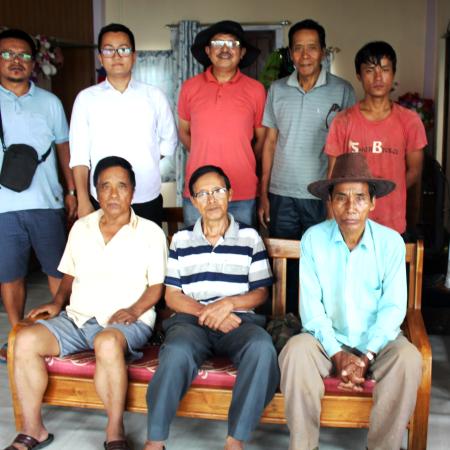
Dans le village de Khawrihnim, les agriculteurs pratiquaient le Jhum depuis des générations et les cultures secondaires, les cultures mixtes et intercalaires d'oléagineux, de légumineuses, de légumes, d'épices et de tubercules, ainsi que le riz comme culture principale, étaient pratiquées dans les champs de Jhum.Bien que les agriculteurs soient conscients des avantages d'un long cycle de jachère et de la régénération de la forêt, ils étaient sceptiques à l'idée de continuer sur la même parcelle de jhum la deuxième année, car ils craignaient une réduction drastique du rendement des cultures en raison de la perte de fertilité du sol. En outre, le village n'y avait jamais pensé, car il se contentait d'utiliser la terre de Jhum pour une année seulement, puisqu'il disposait de suffisamment de terres et que son cycle de Jhum était actuellement de 9 à 10 ans.
Le conseil du village et les agriculteurs ont été convaincus, après l'atelier, qu'une petite modification de leur système de jhum existant par le biais de mesures d'optimisation du jhum leur apporterait d'immenses avantages en augmentant le revenu des ménages tout en préservant la biodiversité et en améliorant les services écosystémiques des utilisateurs de la terre.


